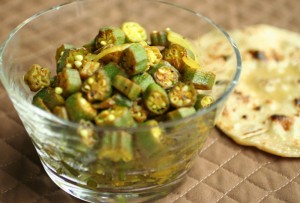Okra Indian Style
Indian cookbook author Shubhra Ramineni lives in Texas, where okra is a popular vegetable and is available year-round. She says that Texans are always surprised to learn that okra is also a popular vegetable in Indian cooking.

Sauteed Okra with Onions and chapati
In the South, okra is prepared in a number of ways: fried, pickled, stewed. And it is a key ingredient in gumbo, where it adds flavor and serves as a thickener.
In New England, where I live, okra is nearly as exotic as fresh curry leaves. It is rare to find it fresh in grocery stores, and even frozen is a gamble. I have sometimes found it at farmers’ markets, but not often. (This is not so surprising because okra grows best in warm climates; it is a relative of cotton, after all.) And okra is highly perishable: once picked it should be used within about three days. So I can see why Northern grocers and farmers are not inclined to take a chance on breaking into the underserved okra market. It’s a catch-22. Northerners don’t often get the chance to experiment with it because it’s hard to find, and grocers and farmers, presumably, don’t want to take a chance with okra not selling because of a lack of interest. What we need is an okra education campaign!
Ms. Ramineni should get a gold star for her work to educate the non–okra eating peoples of the North. In her cookbook Entice with Spice she includes an easy-to-make recipe for Sautéed Okra with Onions (Bhindi Pyaz in Hindi). It requires just a few ingredients and spices—fresh or frozen okra, onions, some all-important lime juice, ground turmeric, cayenne pepper, and black pepper—and salt to season. She includes an important preparation tip in which she explains how to avoid the dreaded “slime” that can be quite off-putting to the uninitiated. The slime that okra releases when cut is natural plant mucilage that has thickening capabilities. (Having planted okra in my garden this summer, I can tell you that the slime is even released from the stem where it is cut from the plant.)
When okra is cooked in liquid the amount of mucilage that is released increases—thus its use in gumbo as a thickener. Apparently the increase in slime also occurs when cut okra simply comes into contact with liquid, which is why Ms. Ramineni stresses the importance of rinsing and patting okra dry BEFORE cutting it. She recounts how the first time she made okra she chopped it and then washed it; the result was slime everywhere.
Another deterrent to slime is acid and, according to Howard McGee in On Food and Cooking, a dry cooking method, like sautéing. Both are employed in Bhindi Pyaz.
I followed the instructions for Sautéed Okra and Onions to the letter and enjoyed slime-free okra. There is a little bit of slime when cutting the okra, but, as Ms. Ramineni promises, it dissipates as it cooks with the lime juice. When making the okra dish I used a combination of frozen okra I’d purchased at Gagan, an Indian market in Burlington, Vermont, and some that I’d grown in my garden and blanched and froze myself. (To learn more about the learning curve of growing okra in the North, read: “Growing Heat-Loving Vegetables in the North”.) I made homemade chapatti, an everyday flatbread, also from Entice with Spice, to go with the okra, which made great light lunch. If you’re new to cooking okra, Ms. Ramineni’s recipe is a great way to get started with this underused vegetable.
